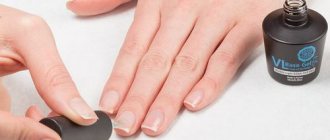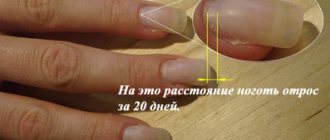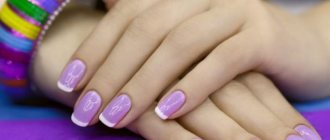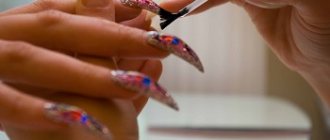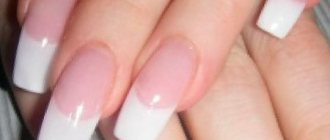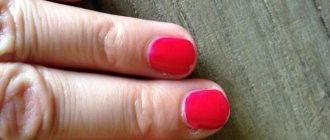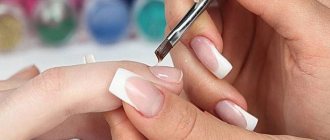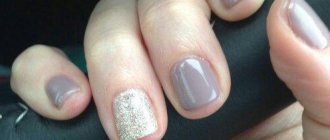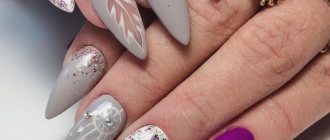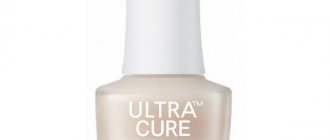Most women are very sensitive to their appearance. The main indicator is elegant, well-groomed hands with a chic manicure. But, unfortunately, many representatives of the fair sex suffer from the fact that Mother Nature gave them nails, the shape of which leaves much to be desired. Moreover, in addition, they flake terribly, constantly break and grow very slowly. In such situations, a nail extension procedure can come to the rescue. This manicure will always look natural and very impressive. Today, many ladies can see extended nails. How long do they last? What is their advantage? What is the time frame for correction? You will learn about all this by reading the article.
Extended nails: how long do they last?
When doing extensions, every woman dreams that her beautiful nails will immaculately please her for a very long time. However, not all representatives of the fairer sex can last this beauty for a significant period of time. A completely fair question arises: extended nails, how long do they last on women’s fingers? What determines the duration of this period? Let's figure it out.
During extension, the surface of the natural nail is significantly filed down, and in its place a new acrylic or gel plate is formed, which can last for 6 months. Correction of an extended nail should be done when, due to the growth of your own nail, the precuticular area becomes not covered with gel or acrylic. This usually happens after 3-4 weeks. In this case, you need to immediately contact your specialist for the next adjustment.
If the changes are minor, then the specialist will not remove the tips and build up a new plate. He will simply eliminate the detachments that have appeared and make cosmetic correction of the nail. Thus, this procedure must be carried out at least once a month, otherwise, after the gel is detached, the tips will need to be removed.
In what cases is it necessary
Correction of gel nails involves a technology that consists of a complete or partial renewal of the previous effect. The need to perform it is due to the fact that any natural nails grow over time - for some faster, for others slower, which is why a small gap forms between the gel polish and the cuticle area. It spoils the visual condition of the manicure and puts them at risk of damage.
Correction of nails after extensions or application of decorative coating in the form of gel polish is usually carried out once every 3-4 weeks. However, many girls neglect the master’s recommendations, preferring to update the work much later.
You should not wear the same coating for too long, since as the nails grow over time, the risk zone and the mechanical load on the free edge increase. This increases the risk of spontaneous nail breakage or premature removal of gel polish.
Before you make a nail correction, pay attention to when it is applied, there are four main cases:
- If more than three weeks have passed since your previous visit to the salon, and the nail has grown sufficiently.
- If you don’t like the visual state of your manicure, you want to update it, change the style or design method.
- The gel base has chips, cracks or other defects that look untidy and increase the risk of continued damage to the surface.
- The gel polish has peeled off from the nail bed. Then correction of gel nails is mandatory, since the resulting space creates favorable microflora for the development of pathogenic bacteria, which is associated with increased humidity in it. Because of this, there is a risk of fungal infection.
It is not recommended to do the procedure too often, since any mechanical impact on the plate during removal of previous work negatively affects the health of the stratum corneum. Because of this, the optimal time to update the methodology is 3 weeks.
Girls' gel polish always lasts for different periods of time. For some, the work can remain in the same state for up to a month and a half, and some clients complain that the result fades after just 2 weeks. This is not always related to the quality of the procedure performed by the master, because there are other factors that affect this, including the individual characteristics of the nails and the girl’s compliance with the master’s recommendations. Despite this, you need to choose the frequency of correction after consulting with your specialist.
How long can you wear extended nails?
The question of how long you can wear extended nails without renewing them worries all ladies who have decided to perform such an action for the first time. The most common factor in correcting false nails is the growth of your own. If your nails grow slowly, then adjustments can be made once every 2 months. And, conversely, with rapid growth, this procedure must be performed every 2-3 weeks. If you strictly follow these instructions, the extended nails will remain stable.
Nail correction with gel – video
Short nails are not for you? Do you have an important event coming up where you need to shine, but your manicure leaves much to be desired? Let's talk about how to give your nails the shape you want and draw attention to your beautiful nails for as long as you want.
Nail correction with gel is a second life for artificial nails that you have already become attached to. In order to preserve their beauty, this procedure should be carried out systematically.
This is especially true for those ladies who cannot imagine themselves without such a hot trend as flawless nails, and strive to always be on top.
If you want to learn this skill yourself in the shortest possible time or simply understand how well a particular master can carry out this operation, step-by-step instructions will help you with this. You will also learn how to properly renew the coating and restore its appearance.
Videos presented on the Internet will help you understand what is included in a quality correction procedure.
Causes of premature detachment of extended nails
Sometimes the answer to the question of how long nail extensions last can be completely ambiguous. This can be purely individual. If you suddenly notice that peeling has appeared on your nails or their shine has completely faded, and very little time has passed since a fresh overlay, then sound the alarm and immediately visit your master.
Causes:
- a mistake made by the master because he incorrectly calculated the architecture of the applied nail;
- the tip is sanded unevenly or the coating is applied very carelessly;
- inflammation of the skin, due to which the applied plate becomes foreign, and a process of rejection occurs;
- fungal disease or the presence of other body disorders;
- medications that interact poorly with foreign bodies;
- your own manicure, which was performed before the extension procedure and was not removed properly;
- hormonal status (nail extensions cannot be done during the menstrual cycle, pregnancy and the early postpartum period).
How often do you need to have your nails done?
The frequency of correction of extended nails depends on the speed of their growth. Typically, nails are cut every 1-2 weeks. If low-quality materials are used during extensions, which can cause peeling of the extended nail plate, then the procedure may be required much earlier. If handled carelessly, one of the nails may crack and break, which also requires correction. In some cases, clients contact salons ahead of schedule to simply change the design.
Nail correction itself in Moscow or any other city takes place in several stages:
- Filing the top layer of the extended nail to give it a smooth surface.
- Correction of nail shape and length.
- Nail design in the same or new design.
- Applying final layers of extension material.
The master’s task during the correction process is not just to glue a new nail, but to reshape the regrown nail. If this is a French manicure, then it should correct the position of the “smile” line and remove excess length. To prevent the overgrown nail from bending down, it is necessary to level the nail plate. It should look beautiful from any angle, so it is important for the master to remove all imperfections so that no traces of correction are noticeable.
In general, the entire procedure takes almost three times less time and money. In some cases, if you go to the same salon where the extension took place, you can count on a discount. The procedure must be repeated on average twice a month. This will help you plan your budget and calculate your expenses in advance.
Delicious recipe! Sour milk bread without yeast in the oven
Regular consultation with a specialist will help maintain a neat appearance of your nails, preserving their health and natural beauty.
Gel coating of extended nails
You need to know that covering extended nails with gel is a safe procedure that has no contraindications, unless you suffer from any allergic disease.
The gel coating procedure is completely safe for people. The materials used do not create any allergic reactions. This cosmetic product is applied quickly, and without any consequences or complications. It is very convenient and effective to use. Thanks to the content of a special chemical composition, it creates a healthy and universal shine of the nail, and also preserves the color of the applied varnish. You will not face any problems with your fingers, since the gel does not damage even very fragile nail plates. After applying the composition to the nails, they need to be dried in a special UV lamp.
In what cases is it necessary to correct nails?
Extension is a procedure in which a layer of gel or acrylic mass is applied to the surface of a natural nail. In this case, the coating occurs in such a way that the material protrudes beyond the edge of the nail plate, giving it the desired length. In some cases, instead of gel-like products, a polymer tip is attached to the nail.
After extensions, the nail plate continues to grow and over time the extended layer begins to protrude above the surface of the nail. This defect is observed several millimeters beyond the cuticle. To hide it, it is necessary to carry out nail correction, consisting of all stages of the initial extension, except for the formation of the base. In some situations, a full extension is required.
Correction of extended nails is necessary in all the following cases:
- if the nails branch more than 4 mm;
- if your nails are cracked or chipped;
- if you need a new nail design;
- if the material has lost its original properties.
You should not delay correction if the nail plate is short and the area of adhesion of materials has significantly decreased. Otherwise, the nail will break, and its correction will take more time and money.
Disadvantages of gel extensions
We already know how long gel nail extensions last. This is their huge advantage. But it's time to mention the shortcomings. Compared to acrylic coating, gel is more brittle and fragile. Even if an acrylic nail can be easily corrected or simply repaired, then if the gel plate breaks this issue disappears by itself, because it cannot be repaired. The broken nail will simply need to be removed and a new one made. The gel also cannot withstand very sudden changes in temperature conditions; it instantly begins to crack. Popularly, gel tip extensions are called reinforced concrete, which means it will be very difficult to remove such luxury. Only the filing procedure will help - long, tedious, and very careful so as not to damage the natural nail.
How to do nail extensions
If you decide to undertake such a difficult procedure yourself, then you need to know how nail extensions are done and how long they last.
- After disinfecting your hands, you need to push back the cuticle with a wooden stick.
- Remove it using a manicure drill.
- Trim off excess dry skin.
- Give a natural nail a rough finish using a 240 grit abrasive file.
- Then you need to choose tips of the appropriate size.
- The appropriate tip for each nail must be adjusted with a nail file so that it fits perfectly on the nail and matches its shape.
- To prevent the hole of the glue bottle from drying out, you need to use a long glue tip.
- Carefully apply the substance to the tip.
- Place it on the nail, pressing for a few seconds to allow the glue to dry.
- Remove any remaining adhesive using a cotton swab or cotton swab.
- Using tweezers for cutting tips, remove the excess part of the extended nail, thereby giving it the desired size.
- Then you need to sand the surface of the tip until rough, especially paying attention to the transition to the natural nail.
- You need to apply a primer to your natural nail.
- Apply a thin layer of gel to the plates.
- Dry for 2 minutes. under a UV lamp.
- Apply a second layer and dry.
- Go to design.
If the procedure is performed correctly, your nails will delight you for 2-3 weeks. After this period, correction will be required.
How to correct extended nails
If you do not want to contact a specialist, and you are confident in your abilities, then you can restore your manicure yourself at home. You will definitely need to order or buy in the online store all the necessary materials and tools. Nail correction at home is justified from a financial point of view if you do it regularly. The main advantages of this solution are that you can make corrections whenever you want and help your friends.
Those who are interested in how to correct nails should first watch the lesson or read the step-by-step instructions with photos so as not to spoil the manicure. In addition to modeling material, you will need to purchase a UV lamp. To simplify the process, you can buy a manicure machine, the only drawback is that you need to learn how to use it and understand the sets of attachments. You don’t have to buy the most powerful router; you definitely don’t need a professional one. Its cost is relatively low, and you will use it for a long time.
Correction of extended nails with gel
This is one of the material options that is used for extensions and modeling. Correction of gel nails involves the use of specific materials that you will have to purchase yourself. For the procedure you need to have:
- degreaser;
- gel;
- modeling gel;
- liquid for removing the sticky layer;
- acid-free primer;
- antiseptic;
- cuticle oil.
This is the most minimal set for correcting extended nails with gel. If you used a single-phase gel for the first time, you can use it for correction. In the case of a three-phase procedure, any system is suitable. Next, you need to have a minimum set of tools that will help you do everything easily and quickly:
- lint-free wipes;
- buff for polishing nails;
- Ultraviolet lamp
- pusher or orange sticks;
- brushes for modeling nails with gel;
- gel files, suitable for 150/180 and 100/100 grit.
- nail clippers for cutting cuticles or blades;
- artificial nail clippers.
Below is a step-by-step description of how to correct gel-based nails. It is very similar to the procedure when working with acrylic. The instructions consist of the following steps:
- Degrease, disinfect hands, tools, remove varnish and paint from the plate (it is better to use products without acetone).
- Use an orange stick to lift the cuticle.
- Using a nail file, correct the shape, first file off those parts of the gel that have begun to lag behind. Then, in the place where the old coating begins at the cuticle, remove all the gel, you should get an imperceptible transition to the natural nail.
- Treat the surface with primer so that the infection does not get under the nail, remove excess with a towel.
- The smooth part of the regrown plate is cut off using a buff. Next, the hole is immediately filled with gel and dried with a UV lamp.
- When the material dries, you need to remove the sticky layer and form the correct shape. Use a file to immediately correct any unevenness, if any. The base layer of gel is applied evenly over all parts of the plate. A little more material is needed for the stress zone (just above the middle of the nail), but do not overdo it. Then dry the material again in a UV lamp.
- Then you need to correct the shape, smooth out defects and unevenness using a nail file. Be careful not to accidentally wear off the base layer to the old coating.
- Remove dust regularly with a brush.
- Before applying the finish, you need to make the desired design (drawing, French).
- Next, apply the finishing coat in one layer and dry under a lamp. To make it smoother, then apply a buff.
- You need to treat the side rollers and cuticles with nourishing oil (rub in like a cream).
Correction of acrylic nails
This type of artificial material is very popular among girls. Correction of nails with acrylic is carried out according to a similar algorithm, as with the option described above. To ensure everything works out correctly, you can use the instructions described below:
- Treat your hands and work surface with a disinfectant.
- Remove the varnish layer with a non-acetone product.
- Treat cuticles with a softening agent. After 2 minutes, use a wooden stick/spatula to remove the pterygium from the natural plate.
- Remove any remaining product using a lint-free cloth. File down the free edge with a nail file and set the desired shape. It is necessary to cut down 2/3 of the thickness of the material.
- Remove shine from the natural nail for better adhesion of the plate to the acrylic.
- Treat the peeling areas with a fine-grain nail file.
- Next, you need to treat the part where there is no acrylic using a degreaser.
- Treat the nail plate with a primer, which connects the keratin of the natural part with the artificial material.
- Run the simulation. Make sure that the acrylic is applied evenly over the entire area and does not penetrate the skin or into the lateral sinuses. Extension brushes should only be made of natural bristles; do not press too hard when applying.
- Then place your hands under a UV lamp for 2.5 minutes.
- Apply special oil to the cuticle.
Nail correction with shellac
This is a new type of coating that is easier to apply and lasts as long as gel/acrylic ones. Nail correction with shellac is carried out in two ways: with or without complete removal. To carry out the procedure, a standard set of instruments is used. Correction of gel polish is carried out according to the following instructions:
- It is recommended to treat nails that are too dry using a special activator. it consists of essential oils and water, apply it to the sides and keep for 5 minutes.
- Use a pusher to pick up the shellac polish. Carefully remove the coating; this is easier to do using the same activator.
- Using a nail file, give the regrown edge the required shape.
- Next, get a manicure or use a special gel to soften the cuticle and push it back.
- Clean the plate with a nail polisher until a shine appears. This step cannot be skipped; then it will be easier to remove the layer if necessary.
- Degrease the surface.
- Coat the substance that replaces the base and finish, dry it under a lamp.
- Select a shade of shellac, apply one layer to the surface, and dry.
- Then another layer, and again you need to dry it.
- Apply finishing coat last and let dry.
- Apply cuticle repair serum.
Nail correction using tips
This procedure is similar in its algorithm to working with gel extensions. Restoring sealing, updating the coating, replenishing modeling materials, giving an aesthetic appearance - all this is the correction of nails using tips. Below is an algorithm for acrylic technology:
- Saw off the overgrown tips with a reversible nozzle and process to a thin substrate.
- File the surface of the nail with a 180 grit file, smooth out the transition from the tip to its own plate.
- Use a spatula to push back the cuticle.
- Use a diamond attachment to perform a hardware manicure.
- Degrease, disinfect the nail, wipe with a napkin (dry).
- Apply a small amount of acid-free primer at the base of the tip.
- Lengthen the nail bed with camouflage acrylic and shape using a brush.
- Model the cuticle growth area and apex with matte, one-time powder.
- Next, you should compress the stress area.
- Use a clothespin to secure the clamp.
- Model the free edge of the nail with white acrylic. You can put it on two tips at once.
- Form the free edges with the base of a thick brush.
- Use the drum attachment (reversible) to file the tip of the nail.
- Treat the inner, longitudinal arch in the same way.
- File the cuticle and apex area with the “corn” attachment.
- Use a 100 grit file to file down the nail plates.
- Sand the inner arch of the nail using the reverse corn attachment.
- Use a carbide tip to treat the hyponychium area (where the inside of the nail comes into contact with the skin).
- Treat the outer and side parts with a 100 grit file and remove dust.
- Coat the inside of the loose tips with finishing gel without sticky salt.
- Cover the outside with gel too.
- Keep your hands under the UV lamp for 2 minutes.
Decide for yourself
The applied varnish on natural nails does not last very long. It constantly needs to be removed and the plate covered again. The same cannot be said if you have extended nails. You already know how long they last. Rich colors and beautiful shape please the eye of its owner for a long time. But it’s very difficult to give natural, even long nails the shape you want. But this seems like a very simple task.
After the extension procedure, natural nails do not become weaker, but on the contrary: under the applied layer of acrylic, gel, or glue, they are not subject to external influences of environmental conditions: they do not freeze, interact well with chemicals, do not scratch, are not afraid of water, and do not lose their color. In addition, most of the materials used for nail extensions contain strengthening and healing substances.
Dear representatives of the fair sex, let's delight ourselves and our stronger half of humanity with our charming fingers!
